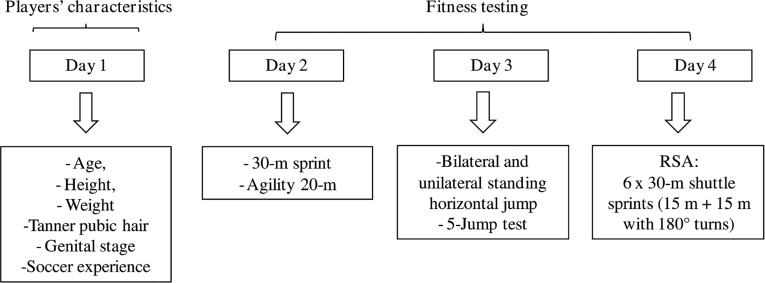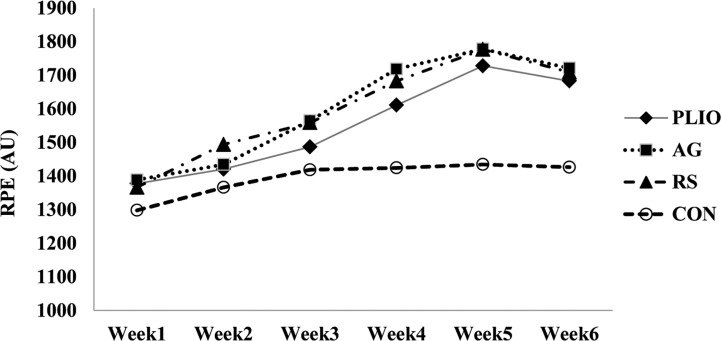Abstract
The aim of the present study was to compare the effects of 3 training protocols (plyometric [PLYO], agility [AG], or repeated shuttle sprints [RS]) on physical performance in the same population of young soccer players. Forty-two youth-level male players (13.6±0.3-years; 1.65±0.07 m; 54.1±6.5 kg; body fat: 12.8±2.6%) participated in a short-term (6-week) randomized parallel fully controlled training study (pre-to-post measurements): PLYO group, n=10; AG group, n=10; RS group, n=12; and control group [CON] n=10. PLYO training = 9 lower limb exercises (2-3 sets of 8-12 repetitions). The AG group performed planned AG drills and direction changes. RS training consisted of 2-4 sets of 5-6x 20 to 30 m shuttle sprints (20 seconds recovery in between). Progressive overload principles were incorporated into the programme by increasing the number of foot contacts and varying the complexity of the exercises. Pre/post-training tests were: bilateral standing horizontal jump, and unilateral horizontal jumps, sprint (30 m with 10 m lap time), agility (20 m zigzag), and repeated sprint ability (RSA) (i.e. 6x30 m shuttle sprints: 2x15 m with 180° turns). Significant main effects for time (i.e. training application) and group (training type) were detected. Improvements in horizontal jumping were higher (p<0.01: ES=large) in PLYO. The RS group improved significantly more (p<0.01; ES=large) than other groups: 30 m sprint, RSAbest and RSAmean performances. Significantly greater increases in 20 m zigzag performance were observed following AG and RS training (4.0 and 3.8%, respectively) compared with PLYO (2.0%) and CON training (0.8%). No significant differences were reported in the RSAdec between groups. Elite young male soccer players’ physical performances can be significantly and specifically improved either using PLYO or AG or RSA training over short-term in-season training.
Keywords: Plyometric training, Agility, Repeated sprint, In-season, Team player
INTRODUCTION
Soccer is an intermittent sport which requires players to undertake many technical, physical, and tactical actions. Previous research suggests that agility (AG), power development, repeated sprint ability (RSA) and endurance capability represent determinant factors for success in soccer [1]. Furthermore, it has been reported that these physical qualities differ significantly between elite level players versus their sub-standard counterparts, and match analysis has further confirmed these statements within soccer [2]. Indeed, contemporary literature suggests that during competitive match play, soccer players perform approximately 723±203 actions, movements and changes of direction (COD) [3]. It has been reported that although sprinting and high intensity actions represent only 10 to 15% of covered running distance, they are extremely decisive for the outcome of the game in both elite male and female soccer [4]. Physiological considerations regarding the effect of training programmes are crucial amongst young players due to their lack of full maturation, and physiological adaptations to training differ from those of adult players. Indeed, it has been reported that the age between 12 and 15 is a crucial period of physical development, where growth hormone and muscle mass increase significantly [5].
The ability of soccer players to continuously perform high-intensity, high-speed actions is known to significantly impact on soccer match performance [6]. Agility is described as a high-speed action that involves rapid COD in response to visual, audio or kinaesthetic stimuli [7]. Agility motor tasks could be reactive or programmed [7]. Scientific literature reported that training programmes that use COD patterns assisted in the improvement of straight sprint performance, the COD ability and the muscular power and strength development [8]. However, many other studies have indicated that the COD training method did not improve these physical qualities [9, 10].
The ability to perform high-speed running actions during a soccer match is an important prerequisite for successful participation in team sports and has been termed repeated sprint ability (RSA) [11, 12]. RSA was defined as a series of short sprints, each separated by short recovery periods [12]. Studies concerning the effect of RS training on physical qualities among young soccer players have produced conflicting results. Some authors found improvement in speed, agility, power and RSA with a training programme composed of repeated high-intensity actions performed in young soccer players [13]. However, other studies found a limited improvement in these physical qualities [14].
Plyometric contractions are quick, powerful movements in which the muscles undergo a rapid elongation followed by an immediate shortening (stretch-shortening contraction), utilizing the elastic energy stored within the stretching phase of the movement [15]. According to scientific literature, plyometric drills represent a safe training method amongst young soccer players [16]. Actually, plyometric exercises require similar movements encountered in the usual playing activities of children without using additional weight. As a result, many studies have analysed the effects of plyometric training on reducing the incidence of injuries, enhancing muscular power, agility and sprint performance (10-30 m straight line sprint) amongst youth and adult soccer players [17]. In that regard, several mechanisms were suggested to explain the improvement in performance with plyometric training. It has been suggested that plyometric training increases the speed of the myotatic stretch reflex and desensitizes the Golgi tendon organ [15], which allows the increase of muscle power and leads to greater force production [15].
It has been reported that high-intensity performance should be well developed throughout childhood and adolescence [18], when the body’s modification emerges (i.e. increase in sex androgen concentrations, increase of muscle cross-sectional area, nervous system development and neuro-plasticity adaptations [19]). Consequently it is important that physical trainers working with youth athletes take into consideration the influence of biological maturation on performance. Although studies on training methods for improving physical fitness amongst young soccer players are widely published, to our knowledge, no study has compared the effects of three different training programmes on physical fitness of the same population of young soccer players.
Therefore, the present investigation aimed to compare the specific effects of three training modalities (i.e. repeated shuttle sprint, agility, and plyometric training) on RSA, straight sprint and agility tests. It was hypothesized that the replacement of some soccer-specific training with plyometric, agility, or repeated shuttle sprint exercises would enhance explosive actions, agility and anaerobic performance (RSA) to a greater extent in young soccer players than soccer training alone.
MATERIALS AND METHODS
Experimental approach to the problem
The aim of the study was to compare the effects of plyometric (PLYO), agility (AG), or repeated sprint (RS) training on physical performance in young male soccer players (U-13). Before and during the 6-week training period (2 sessions per week), power (bilateral standing horizontal jumps, and unilateral horizontal jumps with each of the two legs), running speed (30 m sprint with 10 m lap time), agility (20 m zigzag), and RSA (6x30 m shuttle sprints (15 m+15 m with 180° turns) were assessed. The assessments took place during the hours usually considered for soccer training in these players (i.e. 3-5 p.m.). After the initial measurements, subjects were randomly assigned to a CON group (n = 10) or to 3 other groups that completed PLYO training (n=10), AG training (n=10), or RS training (n=12). The 3 experimental groups performed a specific training protocol (PLYO, AG, or RSA) as a substitute for some soccer drills within the usual 90-minute practice twice per week, 2–3 days apart (i.e. ~20 min per session). The CON group participated in regular soccer training with 4 training sessions per week.
Subjects
Forty-two male elite-level field soccer players belonging to the same team in the Tunisian first league (13.6±0.3-years; 1.65±0.07 m; 54.1±6.5 kg; body fat: 12.8±2.6%) volunteered to participate in this study. All participants were classified as experienced soccer players with 5.9±1.2 years of systematic soccer training. The maturation stage was assessed using Tanner’s pubic hair technique [20]. Pre-study assessment showed players all belonged to maturation stages 2-3 with no significant difference between the composed groups (p>0.05). None of them had already participated in a periodised PLYO, AG or an RS training programme. Written informed consent was obtained from all the players and their guardian/parents after receiving verbal and written information about the nature and the associated risk and benefit involved in this study. Familiarization procedures for testing were performed by all studied players. The study was conducted according to the Declaration of Helsinki and the protocol was fully approved by the Ethics Committee of the Tunisian National Centre of Medicine and Science of Sports (CNMSS) before commencement of the assessments. All players trained four times a week (i.e. ~90 min per session) with a match played during the weekend over the entire training period. All the procedures were carried out during the competitive season to ensure that no large physical changes were made as a result of the conditioning state.
Procedures
One week before commencement of the study, all the subjects participated in two orientation sessions to become familiar with the general environment, equipment, and the experimental procedures to minimize the learning effect during the course of the study. All groups were tested prior to and after the 6-week training period for all variables. Testing sessions were divided into three non-consecutive days spaced by 48 hours, where the order of execution was counterbalanced.
Field tests were carried out on a third-generation synthetic soccer turf, at the same time of day (between 9 am and 11 am) and under similar environmental conditions (temperature 19.0–23°C, no wind). Players were allowed to drink ad libitum in order to avoid dehydration. The internal training load of all players was monitored using the session rate of perceived exertion method (session-RPE) according to the procedures proposed by Impellizzeri et al. [21] and expressed in arbitrary units (AU). All participants were motivated to give their maximum effort during performance measurements, and investigators gave vigorous encouragements throughout. Before testing, subjects executed a standardized 15-minute warm-up including submaximal running, dynamic stretching; low-intensity forward, sideways, and backward running; several acceleration runs; and jumping at a progressively increased intensity. Figure 1 shows a schematic representation of the fitness testing sequence. Following the initial baseline testing session, subjects were randomly divided into three experimental groups (PLYO, AG and RS) and a CON group. Groups were matched for age, maturation status and physical characteristics. Each experimental group participated in a 6-week group-specific training protocol with a frequency of 2 sessions per week performed on non-consecutive days. The AG group performed pre-planned AG drills to accumulate progressive distance and direction changes across the training period [22]. RS training consisted of 2-4 sets of 5-6 x 20 to 30 m (180° turns) sprints interspersed with 20 seconds of passive recovery. The PLYO training was composed of 9 different exercises designed for the lower extremities with 2-3 sets of 8-12 repetitions. Progressive overload principles were incorporated into the programme by increasing the number of jumps and varying the complexity of the exercises.
FIG. 1.
Schematic representation of the fitness testing sequence.
Preliminary testing
The preliminary testing session was used to determine the subject’s height, body mass, body mass index, and percentage body fat. Height and body mass were measured using a stadiometer to the nearest 0.5 cm and a standard electronic scale (accurate to 0.01 kg), respectively. Skinfold thickness was measured to the nearest 0.2 mm at four predetermined sites (biceps, triceps, subscapular, and suprailiac) using Harpenden skinfold callipers (Lange, Cambridge, MA, USA). Body mass, height, BMI and sum of skinfold measure were also collected after training. The pubertal stage was determined by self-assessment questionnaire, in which subjects assessed their genital and pubic hair development according to the criteria of Tanner and Whitehouse [23].
Field tests
Horizontal jumping tests
Each player performed a series of horizontal jumps [16]. The tests included a bilateral standing horizontal jump, and unilateral horizontal jumps with each of the two legs. The results were categorized into dominant (the leg predominantly used for kicking the ball) and non-dominant legs for each player. For these tests, the participant stood stationary on both legs, with the toes aligned at the level with the starting line, before jumping as far forward as possible, with the possibility of using an arm swing. The unilateral horizontal jumps required the athlete to begin by standing on the designated tested leg with their big toe touching the starting line and to jump as far forward as possible, landing on both feet. The distance jumped from (1) the start line at take-off to (2) the position of the rear border of the heel of the closest foot to the starting line upon landing was measured in centimetres using a metal tape measure. The five-jump test (5JT) consisted of covering the greatest horizontal distance possible by achieving five alternate leg jumps [24]. Players were asked to start and end with their feet parallel and to begin the first jump with their preferred leg. The performance in the 5JT was assessed using a fixed measuring tape and was determined to be the distance from the front part of the player’s feet at the starting position to the rear part of the feet at the final landing position. Participants performed three trials spaced by around two minutes, and the best trial was used for statistical analysis.
Straight sprint (SS) tests
SS performance was evaluated using a maximal 30 m sprint (with a 10 m split time). Players were instructed to run as quickly as possible along the 30 m distance from a standing start. The subjects commenced the sprint when ready from a standing start just behind the first timing gate. Stance for the start was consistent for each subject. Time was automatically recorded using photocell gates (Brower Timing Systems, Salt Lake City, Utah, USA, accuracy of 0.01 s) placed 0.4 m above the ground. Subjects performed two trials with ~2 min of rest in between. The timing gate at 10 m recorded the time for the acceleration phase of the sprint (0-10 m). The timing gate at 30 m stopped the timer and recorded the total time taken to sprint 30 m. Time spent in the maximal-velocity phase was calculated by subtracting the acceleration time (0-10 m) from the overall time (0-30 m; Sayers et al. 2008). The best (fastest) 30 m sprinting time and the associated 10 m sprinting time were selected for analysis.
Zigzag agility test
Agility was assessed using an asymmetrical test composed of three CODs of 100° over 5 m each one, before finishing with a final 5 m straight sprint [25]. The cone/post around which the player had to turn was 1 m in height, and this prevented the player leaning and passing his inward shoulder and any other part of his upper body above the turning point. During agility testing, players wore soccer boots that were adapted to the turf and allowed them to have good adherence to the pitch. The familiarity of the subjects with the test and its relative simplicity also meant that learning effects would be minimal. Electronic timing gates were used to record completion times (Brower Timing System, Salt Lake City, UT). Subjects performed two trials of the zigzag test, and the best performance was used for statistical analysis. Two minutes of rest were allowed between trials.
Repeated sprint ability test
The RSA test consisted of 6 repetitions of maximal 30 m shuttle sprints (15+15 m with 180° turns; lasting around 6 s), separated by 20 s of passive recovery (adapted from a previous running test that has been shown to be reliable and valid in estimating RSA [21]). The participants sprinted linearly from the start line for 15 m, touched or slightly exceeded a line on the floor with one foot and then following a 180° COD returned to the start line as fast as possible. After 20 s of passive recovery, the soccer player restarted again. Strong verbal encouragement was provided to each subject during all sprints. Best time in a single trial (RSAbest), mean time (RSAmean) and decrement (RSAdec) were determined according to Fitzsimons et al. [26]. Specifically, the RSAdec was calculated as RSAmean/RSAbest and expressed as percent.
Training programme
The current experiment was completed during a competition period (middle of the season). After the initial baseline testing session, subjects were randomly assigned to one of the four groups (PLYO, AG, RS, or CON).
The CON group did not perform the PLYO, AG or RS training but performed their usual soccer training with 4 training sessions per week (i.e. ~90 min per session). A detailed description of the usual soccer training applied during the competition period is described in Table 1. The 3 experimental groups performed a specific training protocol (PLYO, AG, or RS) as a substitute for some soccer drills (i.e. passing, crossing, ball kicking, corner kicks situations and penalty kicks) within the usual 90-minute practice twice per week, 2-3 days apart (i.e. ~20 min per session). The 6-week training programmes for PLYO, AG and RS groups are detailed in tables 2-4. The AG group performed COD drills to accumulate progressive run distance and direction change numbers across the training period [22]. RS training consisted of 2–4 sets of 5-6 x 20 to 30 m shuttle sprints (interspersed with 20 seconds of passive recovery). The PLYO training was composed of 9 different exercises designed for the lower extremity with 2-3 sets of 8-12 repetitions. The intensity of the programme was increased in accordance with previous PLYO training guidelines [27]. Technical guidance was provided for stance and spinal posture, linearity of jumping kinematics, and landing “quietly with soft knees” for all basic vertical and horizontal jumps. Training volume was defined by the number of foot contacts made during each session, starting with 80 contacts in the first session, increasing to 132 contacts in the final week 5. PLYO drills lasted approximately 5-10 seconds, and at least 90 seconds rest was allowed after each set [28].
TABLE 1.
Usual soccer training session of young soccer players during intervention.
| Exercise | Duration (min) | |
|---|---|---|
| Technical drills | – Ball control, ball pass, ball conduction and dribbling, feints and moves, positional rotations, combination passing, crossing, ball kicking, ball heading. | ~ 20 |
| Tactical drills | – Defending Functional Drills: Functional soccer training for specific defending positions in soccer (like centre defenders, outside backs, etc). – Attacking functional drills: Functional soccer training for specific attacking positions (like centre forwards, wingers, attacking mid-fielders etc). – Corner kicks situations. – Penalty kicks. |
~ 20 |
| Small-sided games (SSG’s) with or without goal | – Keeper and with or without change of soccer rules (e.g., one touch pass, only heading goals) – Attacking SSG’s: One team is coached on a specific coaching objective, (e.g. Coaching Forward Runs, Creating Space, etc). These games may also involve ‘floater’ players or support teams to achieve coaching objectives. – Defending SSGs: One team is coached on a specific coaching objective, e.g. compact defending. These games may also involve ‘floater’ players or support teams to achieve coaching objectives. |
~ 20 |
| Simulated competitive games | ~ 30 | |
TABLE 2.
Periodization of plyometric (PLYO) training (session 2 of every week).
| Exercises | Week 1 | Week 2 | Week 3 | Week 4 | Week 5 | Week 6 | |
|---|---|---|---|---|---|---|---|
| CMJ | 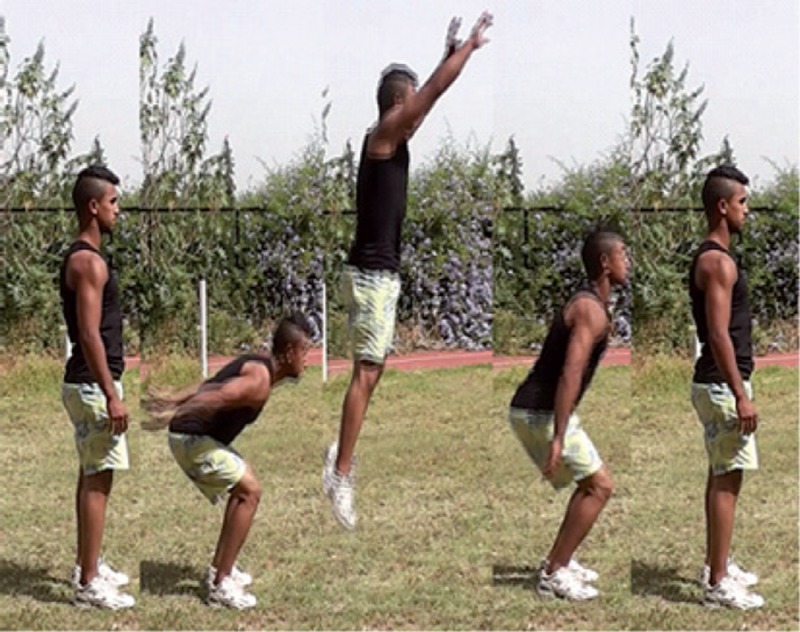 |
2 x 8 | 2 x 10 | 2 x 12 | |||
| Line jump (standing distance jump) | 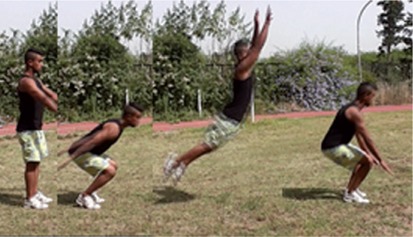 |
2 x 8 | 2 x 10 | 2 x 10 | |||
| Drop jump + 1 step | 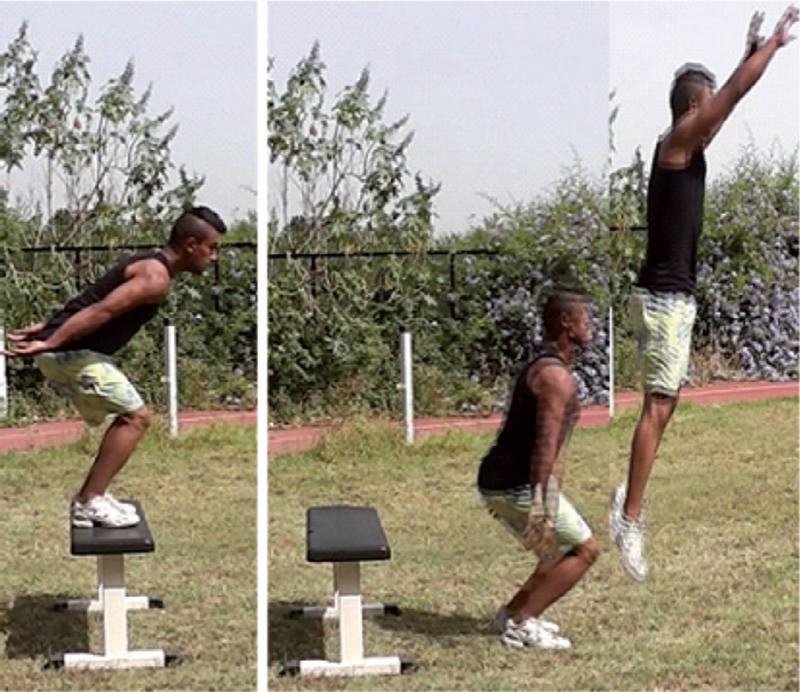 |
2 x 8 | 2 x 8 | 2 x 10 | |||
| Front to back cone hops | 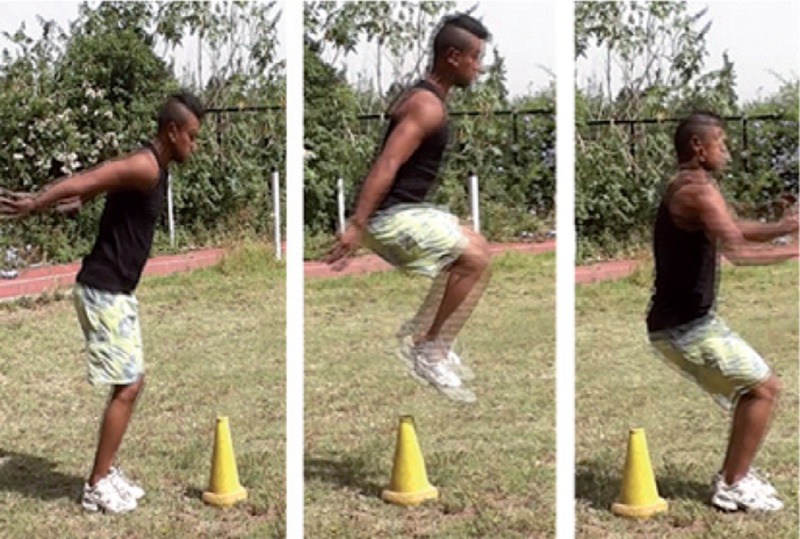 |
2 x 8 | 2 x 10 | 2 x 12 | |||
| Lateral box jump push off | 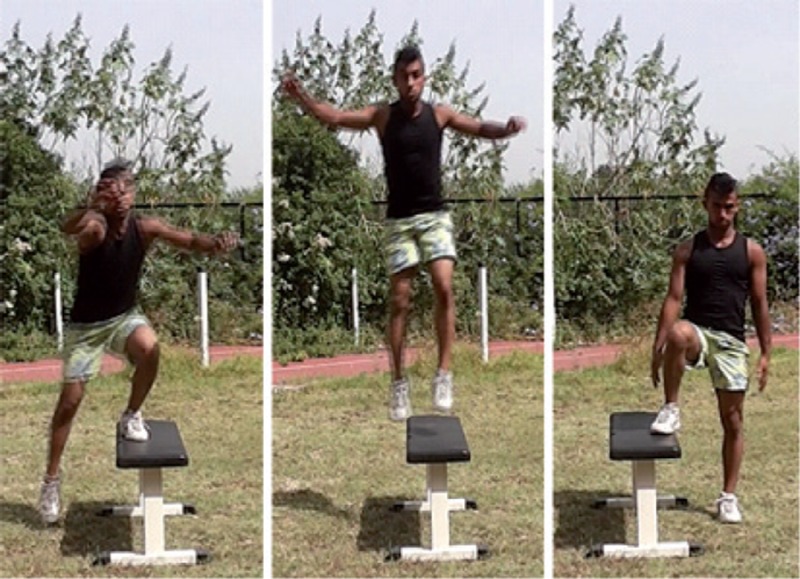 |
2 x 8 | 2 x 8 | 2 x 10 | 3 x 8 | 3 x 8 | 2 x 10 |
| One leg distance jump + 1 step | 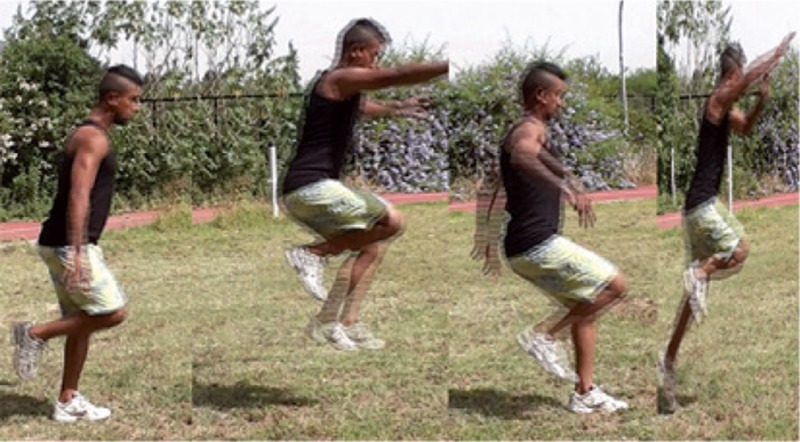 |
3 x 8/leg | 3 x 8/leg | 2 x 10/leg | |||
| Single-leg cone jumps front to back |  |
3 x 8/leg | 3 x 10/leg | 2 x 10/leg | |||
| Single-leg cone jumps side to side | 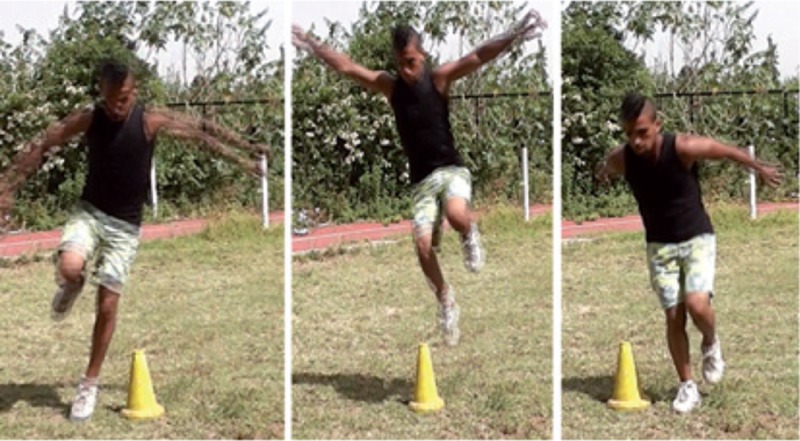 |
3 x 8/leg | 3 x 10/leg | 2 x 10/leg | |||
| Single-leg box Push off | 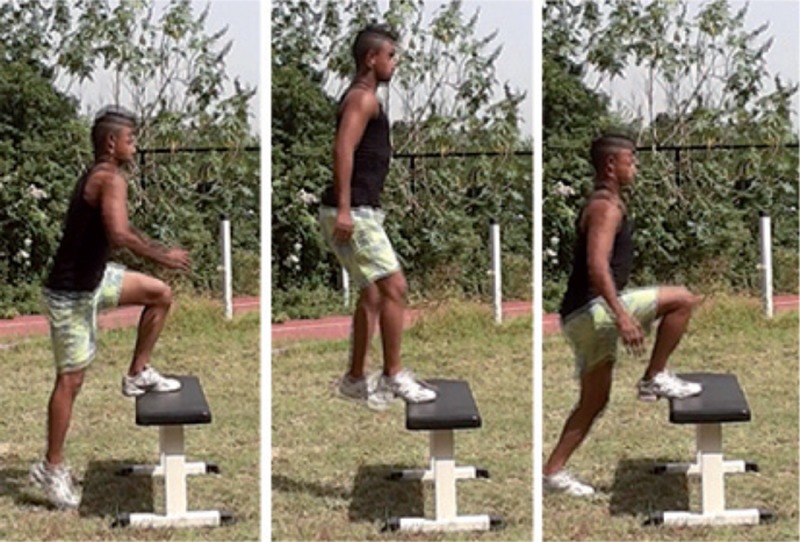 |
3 x 8/leg | 3 x 8/leg | 2 x 10/leg |
TABLE 4.
Periodization of repeated sprint training (session 2 of every week).
| Sets | Exercices | Recovery between | Intensity | ||
|---|---|---|---|---|---|
| Exercices | Sets | ||||
| Week 1 | 3 | 5 x 20 m | 20 s | 4 min | 100% |
| Week 2 | 3 | 6 x 20 m | 20 s | 4 min | 100% |
| Week 3 | 4 | 5 x 20 m | 20 s | 4 min | 100% |
| Week 4 | 3 | 5 x 30 m | 20 s | 4 min | 100% |
| Week 5 | 3 | 6 x 30 m | 20 s | 4 min | 100% |
| Week 6 | 2 | 6 x 30 m | 20 s | 4 min | 100% |
TABLE 3.
Periodization of AG training (session 2 of every week).
| Weeks | Skipping 10m | AG 5-0-5m | Half-T-test 20m | Shuttle 4 x 10m | Total distance (m) | Session AG Number | |
|---|---|---|---|---|---|---|---|
| 1 | S x R r (min) |
2 x 2 1 |
2 x 2 1 |
2 x 2 1 |
2 x 2 2 |
360 | 48 |
| 2 | S x R r (min) |
2 x 3 1 |
2 x 3 1 |
2 x 3 2 |
420 | 66 | |
| 3 | S x R r (min) |
2 x 3 1 |
2 x 3 1 |
2 x 3 2 |
480 | 72 | |
| 4 | S x R r (min) |
2 x 3 1 |
2 x 3 1 |
2 x 3 1 |
2 x 3 2 |
540 | 72 |
| 5 | S x R r (min) |
2 x 4 1 |
2 x 4 1 |
2 x 4 2 |
560 | 88 | |
| 6 | S x R r (min) |
2 x 2 1 |
2 x 2 1 |
2 x 4 1 |
2 x 3 2 |
520 | 78 |
S = Series; R = Repetition; r = recovery time; AG = Agility.
Statistical analyses
Means ± standard deviations (SD) were used to describe variables. Before using parametric tests, the assumption of normality was verified using the Kolmogorov-Smirnov test. The data were then analysed using multivariate analysis of variance (4x2) with repeated measures on the second factor. The factors included four separate groups of training (PLYO, AG, RS, and CON) and repeated measures of time (pre- and post-training). Because of the slight differences in the initial groups, analysis of covariance with the pre-test values as the covariate was used to determine significant differences between the post-test adjusted means in the groups. An analysis of covariance with the pre-test values as the covariate was used to determine significant differences between the post-test adjusted means in groups. If significant main effects were present, Bonferroni post-hoc analysis was performed. The effect size was calculated for all ANCOVAs using a partial eta-squared. The values of 0.01, 0.06 and 0.15 were considered as small, medium and large cut-off points, respectively (Cohen, 1988). Effect size (ES) was also calculated for all paired comparisons and evaluated with the method described by Cohen (Cohen 1988) (small < 0.50, moderate = 0.50-0.80 and large > 0.80). Reliability of the measures (dependent variables) was assessed twice over a number of days with Cronbach’s model intraclass correlation coefficient (ICC), standard error of measurements (SEM) and coefficient of variation (CV) according to the method of Hopkins (Hopkins, 2000). Statistical analyses were performed using the SPSS software statistical package (SPSS Inc., Chicago, IL, version. 16.0), and statistical significance was set at P < 0.05.
RESULTS
Before training no significant differences were observed between groups in the horizontal jumping test, 30 m sprint time, COD speed and total time of the RSA test. No significant pre-to-post training variations in anthropometric and maturation variables were found in the studied groups. The ICC and SEM values for all measures demonstrated high reliability: 30 m sprint (ICC=0.95; SEM=0.16s), horizontal jumping tests (ICC and SEM ranged from 0.86 to 0.95 and from 0.06 to 0.09m, respectively), zigzag test over 20 m (ICC = 0.88, SEM = 0.10 s), RSA total time (ICC = 0.87, SEM = 0.10 s). Weekly session-RPEs were not significantly different between PLYO, AG and RS groups across the training period (from 1378±89 to 1683±78, from 1389±102 to 1721±98 AU, and from 1367±106 to 1709±102 AU). However, the CON group experienced weekly session-RPEs (from 1298±98 to 1427±87 AU) significantly lower than for PLYO, AG and RS groups (p<0.01; Large) (Figure 2).
FIG. 2.
Weekly session-RPEs of different training programmes.
Horizontal jumping tests
The covariance analysis for the horizontal jumping tests indicated significant differences between the PLYO, AG, RS and CON groups (p<0.001; η2=large). Post-hoc analysis indicated that at post-training the PLYO group performed significantly better than the AG and RS groups. Both latter groups performed significantly better than the CON group (Table 5).
Table 5.
Effect of 6 weeks of training on physical performance (mean ± SD). PLYO = Plyometric, AG = Agility, RSA= Repeated sprint, and CON = Control group, BSHJ = Bilateral standing horizontal jump.
| Pre-test | Post-test | Change (%) | Cohen‘s d | Effect condition | ||||
|---|---|---|---|---|---|---|---|---|
| p-value | ES (η2) | |||||||
| Sprint | 0-10m (s) | PLYO | 1.92±0.06 | 1.87±0.07**d | 2.50 | Large | 0.000 | Large |
| AG | 1.91±0.03 | 1.87±0.03**d | 1.99 | Large | ||||
| RS | 1.90±0.07 | 1.82±0.06**a.b.d | 4.20 | Large | ||||
| CON | 1.90±0.06 | 1.89±0.06* | 0.89 | Small | ||||
| 10- 30m (s) | PLYO | 2.76±0.08 | 2.74±0.08* | 0.83 | Small | 0.83 | Small | |
| AG | 2.76±0.11 | 2.73±0.09* | 0.94 | Small | ||||
| RS | 2.78±0.09 | 2.75±0.07* | 1.23 | Small | ||||
| CON | 2.76±0.08 | 2.75±0.09 | 0.54 | Small | ||||
| 0-30m (s) | PLYO | 4.68±0.10 | 4.61±0.10**d | 1.52 | Moderate | 0.000 | Large | |
| AG | 4.67±0.10 | 4.61±0.08**d | 1.37 | Moderate | ||||
| RS | 4.68±0.09 | 4.57±0.07**a.b.d | 2.44 | Large | ||||
| CON | 4.67±0.07 | 4.64±0.08* | 0.69 | Small | ||||
| Horizontal right leg (m) | PLYO | 1.51±0.04 | 1.65±0.07**b.c.d | 8.99 | Large | 0.000 | Large | |
| AG | 1.50±0.11 | 1.57±0.13**d | 4.40 | Moderate | ||||
| RS | 1.52±0.08 | 1.59±0.09**d | 4.50 | Large | ||||
| CON | 1.48±0.08 | 1.50±0.09* | 1.35 | Small | ||||
| Horizontal left leg (m) | PLYO | 1.54±0.04 | 1.66±0.08**b.c.d | 7.93 | Large | 0.001 | Large | |
| AG | 1.53±0.12 | 1.59±0.15*d | 4.39 | Moderate | ||||
| RS | 1.53±0.10 | 1.60±0.10**d | 4.24 | Moderate | ||||
| CON | 1.51±0.09 | 1.52±0.10 | 0.99 | Small | ||||
| BSHJ (m) | PLYO | 1.73±0.08 | 1.85±0.07**b.c.d | 6.70 | Large | 0.000 | Large | |
| AG | 1.69±0.14 | 1.75±0.14**d | 3.80 | Small | ||||
| RS | 1.70±0.09 | 1.76±0.09**d | 3.48 | Moderate | ||||
| CON | 1.69±0.08 | 1.72±0.08** | 1.60 | Small | ||||
| 5-Jump (m) | PLYO | 9.26±0.39 | 10.17±0.46**b.c.d | 9.82 | Large | 0.001 | Large | |
| AG | 9.23±0.97 | 9.89±0.87**d | 7.08 | Moderate | ||||
| RS | 9.28±0.65 | 9.79±0.59**d | 5.52 | Moderate | ||||
| CON | 9.29±0.72 | 9.56±0.74* | 2.93 | Small | ||||
| Zigzag 20m (s) | PLYO | 7.10±0.23 | 6.95±0.17**d | 2.04 | Moderate | 0.000 | Large | |
| AG | 7.14±0.18 | 6.86±0.17**a.d | 4.02 | Large | ||||
| RS | 7.15±0.20 | 6.88±0.14**a.d | 3.84 | Large | ||||
| CON | 7.12±0.22 | 7.07±0.21 | 0.78 | Small | ||||
| RSAbest (s) | PLYO | 6.30±0.26 | 6.26±0.26**d | 0.73 | Small | 0.003 | Large | |
| AG | 6.31±0.26 | 6.26±0.27*d | 0.87 | Small | ||||
| RS | 6.31±0.18 | 6.20±0.15**a.b.d | 1.69 | Moderate | ||||
| CON | 6.30±0.21 | 6.30±0.18 | 0.06 | Small | ||||
| RSAmean (s) | PLYO | 6.51±0.28 | 6.46±0.28**d | 0.81 | Small | 0.000 | Large | |
| AG | 6.53±0.26 | 6.47±0.25*d | 0.90 | Small | ||||
| RS | 6.53±0.13 | 6.42±0.14**a.b.d | 1.79 | Large | ||||
| CON | 6.56±0.22 | 6.57±0.23 | 0.22 | Small | ||||
Significant difference from pre to post (p < 0.05)
Significant difference from pre to post (p < 0.01)
Significantly different from PLYO
Significantly different from AG
Significantly different from RS
Significantly different from CON (p < 0.05).
Linear sprinting
A significant group effect was observed for the overall sprint time (F=11.4; p<0.001; η2=large) and acceleration (F=12.88; p<0.001; η2=large). Significantly greater improvements in overall sprint time and acceleration were found in the RS group (2.4 and 4.2% respectively) compared to the PLYO group (1.5 and 2.5% respectively), AG group (1.4 and 2.0% respectively) and CON group (0.7 and 0.9% respectively). Both PLYO and AG groups performed significantly better than the CON group (Table 5).
Change of direction speed
Significantly greater increases in 20 m zigzag were seen following AG and RS training (4.0 and 3.8% respectively) compared with the PLYO (2.0%) and CON (0.8%) training. Further, the PLYO training increased 20 m zigzag significantly more than CON training (p<0.05) (Table 5).
Repeated sprint ability test (RSA)
The analysis revealed a significant group effect for RSA best time (F=5.53; p<0.003; η2=large) and mean time (F=5.85; p<0.001; η2=large). The RS group achieved significantly greater improvements in RSA best and time and RSA mean time (1.7 and 1.8% respectively; ES=large) than PLYO (0.7 and 0.8% respectively) and AG (0.9 and 0.9% respectively) groups. Both PLYO and AG groups performed significantly better than the CON group (Table 5). No significant differences were observed between groups in percentage decrement (F=0.71; p>0.55, η2=trivial).
DISCUSSION
The primary aim of this study was to compare the effects of three different training types (PLYO, AG, and RS) on physical performance in prepubescent soccer players across a 6-week in-season period. To our knowledge this is the first study that has compared the 3 types of training simultaneously in the “same” population of young soccer players. Thus, the “logical specificity of the training effect” could be drawn from a stronger study design compared to having three separate studies.
The main findings of the present investigation have shown greater improvements in horizontal jumping among the PLYO group (p<0.01: ES=large) when compared across the other training groups. Moreover, the RS group improved significantly more (p <0.01; ES=large) than other groups in acceleration (0-10 m), overall sprint (0-30 m), RSAbest and RSAmean. Furthermore, significantly greater increases were found in the 20 m zigzag test following the AG and RS training programmes (4.0 and 3.8% respectively) when compared with both the PLYO (2.0%) and CON training (0.8%).
The results indicated that PLYO training was the better training programme for improving power performance among young soccer players. This result is in line with the scientific literature [9, 14, 29]. Indeed, Buchheit et al. [14] reported greater improvement in counter-movement jump performance in the PLYO group compared to the RS group (7.7% vs. 3.7%, respectively). In that regard, Sedano et al. [29] indicated that PLYO training was the better method for improving power performance among soccer players. Recently, Ramirez- Campillo et al. [16] reported a significant improvement in muscular power during 6 weeks of PLYO training (unilateral, bilateral and combined) among young soccer players. The greater improvement of power performance after PLYO training when compared to other training programmes could be explained by the physiological adaptations induced by jumping training [30, 31]. Indeed, PLYO training allows greater muscles stiffness at the ground contact and a better use of elastic energy when jumping [32]. Moreover, this kind of training increases muscle activity as a result of earlier activation of the stretch reflex [32]. Finally, PLYO training increases desensitization of the Golgi tendon organ, allowing the increase of muscle power and leading to an enhancement in neuromuscular coordination and subsequent greater force production [33]. The results of the present study also showed a significant improvement in power performance following COD and RS training. These results were also in accordance with previous studies [34–36]. Indeed, Jovanovic et al. [34] indicated that 8 weeks of a specific COD training programme appears to be an effective way of improving power performance in young soccer players. Furthermore, Lockie et al. [35] suggested that complex AG training can be used to enhance explosive muscle power and dynamic athletic performance. Moreover, and according to the meta-analysis presented by Taylor et al. [36], RS sprint training can induce small to large improvements in muscular power amongst already trained players. According to the latter study, improvements in muscular power are possibly due to muscular adaptations. Indeed, it has been reported that RS training increases muscle metabolites (e.g. phosphocreatine and glycogen) and enzymatic activities [37]. Moreover, this kind of training may induce beneficial changes in the patterns of muscular activity, where well-trained athletes adopt muscle activation which will lead to improvements in muscular efficiency via neural pathways and reduced muscular co-contractions [38]. Finally, RS training may improve contractile properties of the leg extensor muscles which results in a significant improvement in lower legs muscular power [39].
The ability to change direction is crucial in team sports (e.g. soccer) [6]. Contemporary literature suggests that COD ability could be optimized by straight sprint training, specific agility exercises, muscular strengthening or by repeated high-intensity actions. However, no consensus has been reached yet regarding the most efficient methodology to improve COD ability amongst prepubescent soccer players. The present study showed that the AG group improved their COD ability significantly more when compared to PLYO and CON groups. This result is in line with many previous studies [22, 40]. Indeed, Milanovic et al. [40] reported a significant improvement of COD ability among young soccer players following 12 weeks of in-season specific COD training. Furthermore, Chaouachi et al. [22] found among young soccer players that 6 weeks of in-season specific COD training increased COD performance significantly more (20 m agility test) when compared to small-sided game training (5% vs. 2.46%, respectively). Therefore, the results of the present study along with those of previous studies suggest that specific AG training represents the most efficient method for improving COD ability in adolescent soccer players. In the same context, the present study showed that RS training also improved COD ability, as did specific COD training. This result was in accordance with scientific literature [10]. Indeed, Shalfawi et al. [10] reported that in-season RS training in combination with AG training significantly improved COD ability amongst female elite soccer players. Therefore, we speculate that RS training may improve the sequencing of muscle activation and the recruitment of muscle fibres.
Furthermore, the results of the present study showed that the RSA group improved their straight-line sprint performance (0-10 m and 0-30 m) significantly more when compared with AG and PLYO groups. However, there was no significant difference between groups in the 10 to 30 m straight sprint performance. The result of the present study was also in line with scientific literature [36]. Indeed, it has been indicated that RS training allowed improvement in maximal speed (30 m) among young elite soccer players. In that regard, the meta-analysis conducted by Taylor et al. [36] indicated that RS training had a very small beneficial effect on 10 m straight line sprint performances (i.e. acceleration phase; effect size = -0.42). However, the latter study reported that the RS training had a very large effect on 30 m straight line sprint performances (effect size = -1.01). It is important to note that in elite soccer players, the 10 m sprint and accelerations are very important for soccer success [13]. In the same context, the present study showed that PLYO and AG training also improved linear sprinting performance. However, the percentage of improvement was lower compared with RS training. Many physiological adaptations may explain the large improvement in linear sprinting following RS training. Indeed, Rodas et al. [37] suggested that the increase of muscle metabolites and enzymes following RS training might explain the improvement of linear sprinting performance. Moreover, Lieberman et al. [41] suggested that RS training might improve linear sprinting by increasing the activity of relatively inactive/untrained muscles. However, Los Arcos et al. [42] suggested that the improvement of linear sprinting ability may be due to an improvement of the contractile properties of the leg extensor muscles which improved force production during sprinting tasks.
Although soccer performance relies on an endurance prerequisite, it is the short, repeated explosive actions that generally determine the outcome of the match, and this is where the need to ensure a more specific training programme is incorporated within players’ training plan. Therefore, the present study indicated that the RS training programme allowed a better RS performance when compared to PLYO and AG training methods. The result of the present study was in accordance with previous studies [14, 43]. Indeed, it has been reported that an RS training programme improved the RS performance significantly more when compared to PLYO training [14]. According to the scientific literature, the strong similarities between RSA testing and RS training routines represent the more likely hypothesis that may explain the results of the present study [44]. In that regard, it has been suggest that the most appropriate way to train RSA is to perform RSA sprint training [43]. The present study also showed that AG and PLYO training may improve RSA among prepubescent soccer players. Similar to the findings of the present study, Buchheit et al. [14] reported a significant but lesser improvement in RSAbest following PLYO training. However, no significant improvement in RSAmean was reported by the latter study, contrary to the present study.
Finally, the present investigation revealed no significant pre-to-post training variations in anthropometric variables. The latter result was contradictory to the finding of Milanovic et al. [45], who reported a significant improvement in body composition variables among young adult men after 12 weeks of training. However, we speculate that this result could be attributed to the differences between the two studies in terms of players’ maturation and the duration of training programmes.
Practical application
This investigation has revealed that despite an improved physical performance outcome using either of the training methods, the PLYO training programme seems to be the most efficient and specific method to enhance jumping performance. Therefore, it may be suggested that in order to maximize the development of power performance among elite young soccer players, specific PLYO training methods should be incorporated. Furthermore, the present study revealed that AG and RS exercises significantly improved COD performance when compared to other methodologies within this training intervention study. Moreover, the present study suggests that practitioners involved within the physical development of players could utilize the RS training method for simultaneous improvement of the straight line sprinting and RSA-based performance enhancement. Finally, the findings of the present study suggest that when working with groups of players around this maturation stage, they should include a range of these training methods discussed in the habitual training sessions of players in order to ensure a global improvement in physical fitness among young soccer players. In this regard, future studies investigating the effect of mixing the interventions used in the present study are warranted in order to try to optimize the training time/training effects of physical training in elite youth soccer players.
CONCLUSIONS
The present study revealed that the best way to improve the straight-line sprinting and RSA performances was to integrate specific RS-based training methods into the traditional technical training programme. Moreover, the present study showed that PLYO training was the more efficient method to improve lower limb power performance vs. any of the other training interventions used. To conclude, it can be confirmed that the replacement of some soccer-specific training with plyometric, agility, or repeated shuttle sprint exercises would enhance explosive actions, agility and anaerobic performance to a greater extent in young soccer players than soccer training alone.
Acknowledgments
This study was supported by the Tunisian Ministry of Scientific Research Technology and Development of Competences. The authors thank the coaches and the athletes for their cooperation.
Conflict of interests
The authors declared no conflict of interests regarding the publication of this manuscript.
REFERENCES
- 1.Owen AL, Wong DP, Dunlop G, Groussard C, Kebsi W, Dellal A, et al. High Intensity Training and Salivary Immunoglobulin-a Responses in Professional Top-Level Soccer Players: Effect of Training Intensity. J Strength Cond Res. 2014 doi: 10.1519/JSC.0000000000000380. [DOI] [PubMed] [Google Scholar]
- 2.Mujika I, Santisteban J, Impellizzeri FM, Castagna C. Fitness determinants of success in men’s and women’s football. J Sports Sci. 2009;27(2):107–114. doi: 10.1080/02640410802428071. [DOI] [PubMed] [Google Scholar]
- 3.Bloomfield J, Polman R, O’Donoghue P. Physical demands of different positions in FA Premier League soccer. J Sports Sci Med. 2007;6(1):63–70. [PMC free article] [PubMed] [Google Scholar]
- 4.Gabbett TJ, Mulvey MJ. Time-motion analysis of small-sided training games and competition in elite women soccer players. J Strength Cond Res. 2008;22(2):543–552. doi: 10.1519/JSC.0b013e3181635597. [DOI] [PubMed] [Google Scholar]
- 5.Lloyd RS, Oliver JL, Faigenbaum AD, Myer GD, De Ste Croix MB. Chronological age vs. biological maturation: implications for exercise programming in youth. J Strength Cond Res. 2014;28(5):1454–1464. doi: 10.1519/JSC.0000000000000391. [DOI] [PubMed] [Google Scholar]
- 6.Little T, Williams AG. Specificity of acceleration, maximum speed, and agility in professional soccer players. J Strength Cond Res. 2005;19(1):76–78. doi: 10.1519/14253.1. [DOI] [PubMed] [Google Scholar]
- 7.Sheppard JM, Young WB. Agility literature review: classifications, training and testing. J Sports Sci. 2006;24(9):919–932. doi: 10.1080/02640410500457109. [DOI] [PubMed] [Google Scholar]
- 8.Condello G, Minganti C, Lupo C, Benvenuti C, Pacini D, Tessitore A. Evaluation of change-of-direction movements in young rugby players. Int J Sports Physiol Perform. 2013;8(1):52–56. doi: 10.1123/ijspp.8.1.52. [DOI] [PubMed] [Google Scholar]
- 9.Castillo-Rodriguez A, Fernandez-Garcia JC, Chinchilla-Minguet JL, Carnero EA. Relationship between muscular strength and sprints with changes of direction. J Strength Cond Res. 2012;26(3):725–732. doi: 10.1519/JSC.0b013e31822602db. [DOI] [PubMed] [Google Scholar]
- 10.Shalfawi SA, Haugen T, Jakobsen TA, Enoksen E, Tonnessen E. The effect of combined resisted agility and repeated sprint training vs. Strength training on female elite soccer players. J Strength Cond Res. 2013;27(11):2966–2972. doi: 10.1519/JSC.0b013e31828c2889. [DOI] [PubMed] [Google Scholar]
- 11.Gharbi Z, Dardouri W, Haj-Sassi R, Chamari K, Souissi N. Aerobic and anaerobic determinants of repeated sprint ability in team sports athletes. Biol Sport. 2015;32(3):207–212. doi: 10.5604/20831862.1150302. [DOI] [PMC free article] [PubMed] [Google Scholar]
- 12.Hoffmann JJ, Jr., Reed JP, Leiting K, Chiang CY, Stone MH. Repeated sprints, high-intensity interval training, small-sided games: theory and application to field sports. Int J Sports Physiol Perform. 2014;9(2):352–357. doi: 10.1123/ijspp.2013-0189. [DOI] [PubMed] [Google Scholar]
- 13.Stolen T, Chamari K, Castagna C, Wisloff U. Physiology of soccer: an update. Sports Med. 2005;35(6):501–536. doi: 10.2165/00007256-200535060-00004. [DOI] [PubMed] [Google Scholar]
- 14.Buchheit M, Mendez-Villanueva A, Delhomel G, Brughelli M, Ahmaidi S. Improving repeated sprint ability in young elite soccer players: repeated shuttle sprints vs. explosive strength training. J Strength Cond Res. 2010;24(10):2715–2722. doi: 10.1519/JSC.0b013e3181bf0223. [DOI] [PubMed] [Google Scholar]
- 15.Wilk KE, Voight ML, Keirns MA, Gambetta V, Andrews JR, Dillman CJ. Stretch-shortening drills for the upper extremities: theory and clinical application. J Orthop Sports Phys Ther. 1993;17(5):225–239. doi: 10.2519/jospt.1993.17.5.225. [DOI] [PubMed] [Google Scholar]
- 16.Ramirez-Campillo R, Burgos CH, Henriquez-Olguin C, Andrade DC, Martinez C, Alvarez C, et al. Effect of unilateral, bilateral, and combined plyometric training on explosive and endurance performance of young soccer players. J Strength Cond Res. 2015;29(5):1317–1328. doi: 10.1519/JSC.0000000000000762. [DOI] [PubMed] [Google Scholar]
- 17.Wong PL, Chamari K, Wisloff U. Effects of 12-week on-field combined strength and power training on physical performance among U-14 young soccer players. J Strength Cond Res. 2010;24(3):644–652. doi: 10.1519/JSC.0b013e3181ad3349. [DOI] [PubMed] [Google Scholar]
- 18.Eisenmann JC, Malina RM. Age- and sex-associated variation in neuromuscular capacities of adolescent distance runners. J Sports Sci. 2003;21(7):551–557. doi: 10.1080/0264041031000101845. [DOI] [PubMed] [Google Scholar]
- 19.Tonson A, Ratel S, Le Fur Y, Cozzone P, Bendahan D. Effect of maturation on the relationship between muscle size and force production. Med Sci Sports Exerc. 2008;40(5):918–925. doi: 10.1249/MSS.0b013e3181641bed. [DOI] [PubMed] [Google Scholar]
- 20.Malina RM, Eisenmann JC, Cumming SP, Ribeiro B, Aroso J. Maturity-associated variation in the growth and functional capacities of youth football (soccer) players 13-15 years. Eur J Appl Physiol. 2004;91(5-6):555–562. doi: 10.1007/s00421-003-0995-z. [DOI] [PubMed] [Google Scholar]
- 21.Impellizzeri FM, Rampinini E, Castagna C, Bishop D, Ferrari Bravo D, Tibaudi A, et al. Validity of a repeated-sprint test for football. Int J Sports Med. 2008;29(11):899–905. doi: 10.1055/s-2008-1038491. [DOI] [PubMed] [Google Scholar]
- 22.Chaouachi A, Chtara M, Hammami R, Chtara H, Turki O, Castagna C. Multidirectional sprints and small-sided games training effect on agility and change of direction abilities in youth soccer. J Strength Cond Res. 2014;28(11):3121–3127. doi: 10.1519/JSC.0000000000000505. [DOI] [PubMed] [Google Scholar]
- 23.Tanner JM, Whitehouse RH. Clinical longitudinal standards for height, weight, height velocity, weight velocity, and stages of puberty. Arch Dis Child. 1976;51(3):170–179. doi: 10.1136/adc.51.3.170. [DOI] [PMC free article] [PubMed] [Google Scholar]
- 24.Chamari K, Chaouachi A, Hambli M, Kaouech F, Wisloff U, Castagna C. The five-jump test for distance as a field test to assess lower limb explosive power in soccer players. J Strength Cond Res. 2008;22(3):944–950. doi: 10.1519/JSC.0b013e31816a57c6. [DOI] [PubMed] [Google Scholar]
- 25.Mirkov D, Nedeljkovic A, Kukolj M, Ugarkovic D, Jaric S. Evaluation of the reliability of soccer-specific field tests. J Strength Cond Res. 2008;22(4):1046–1050. doi: 10.1519/JSC.0b013e31816eb4af. [DOI] [PubMed] [Google Scholar]
- 26.Fitzsimons M, Dawson B, Ward D, Wilkinson A. Cycling and running tests of repeated sprint ability. Aust J Sci Med Sport. journal;1993:2582–2587. [Google Scholar]
- 27.Lloyd RS, Oliver JL, Hughes MG, Williams CA. Age-related differences in the neural regulation of stretch-shortening cycle activities in male youths during maximal and sub-maximal hopping. J Electromyogr Kinesiol. 2012;22(1):37–43. doi: 10.1016/j.jelekin.2011.09.008. [DOI] [PubMed] [Google Scholar]
- 28.Meylan C, Malatesta D. Effects of in-season plyometric training within soccer practice on explosive actions of young players. J Strength Cond Res. 2009;23(9):2605–2613. doi: 10.1519/JSC.0b013e3181b1f330. [DOI] [PubMed] [Google Scholar]
- 29.Sedano S, Matheu A, Redondo JC, Cuadrado G. Effects of plyometric training on explosive strength, acceleration capacity and kicking speed in young elite soccer players. J Sports Med Phys Fitness. 2011;51(1):50–58. [PubMed] [Google Scholar]
- 30.Attene G, Iuliano E, Di Cagno A, Calcagno G, Moalla W, Aquino G, et al. Improving neuromuscular performance in young basketball players: plyometric vs. technique training. J Sports Med Phys Fitness. 2015;55(1-2):1–8. [PubMed] [Google Scholar]
- 31.Attene G, Laffaye G, Chaouachi A, Pizzolato F, Migliaccio GM, Padulo J. Repeated sprint ability in young basketball players: one vs. two changes of direction (Part 2) J Sports Sci. 2015;33(15):1553–1563. doi: 10.1080/02640414.2014.996182. [DOI] [PubMed] [Google Scholar]
- 32.Markovic G, Mikulic P. Neuro-musculoskeletal and performance adaptations to lower-extremity plyometric training. Sports Med. 2010;40(10):859–895. doi: 10.2165/11318370-000000000-00000. [DOI] [PubMed] [Google Scholar]
- 33.Kotzamanidis C. Effect of plyometric training on running performance and vertical jumping in prepubertal boys. J Strength Cond Res. 2006;20(2):441–445. doi: 10.1519/R-16194.1. [DOI] [PubMed] [Google Scholar]
- 34.Jovanovic M, Sporis G, Omrcen D, Fiorentini F. Effects of speed, agility, quickness training method on power performance in elite soccer players. J Strength Cond Res. 2011;25(5):1285–1292. doi: 10.1519/JSC.0b013e3181d67c65. [DOI] [PubMed] [Google Scholar]
- 35.Lockie RG, Schultz AB, Callaghan SJ, Jeffriess MD. The effects of traditional and enforced stopping speed and agility training on multidirectional speed and athletic function. J Strength Cond Res. 2014;28(6):1538–1551. doi: 10.1519/JSC.0000000000000309. [DOI] [PubMed] [Google Scholar]
- 36.Taylor J, Macpherson T, Spears I, Weston M. The effects of repeated-sprint training on field-based fitness measures: a meta-analysis of controlled and non-controlled trials. Sports Med. 2015;45(6):881–891. doi: 10.1007/s40279-015-0324-9. [DOI] [PubMed] [Google Scholar]
- 37.Rodas G, Ventura JL, Cadefau JA, Cusso R, Parra J. A short training programme for the rapid improvement of both aerobic and anaerobic metabolism. Eur J Appl Physiol. 2000;82(5-6):480–486. doi: 10.1007/s004210000223. [DOI] [PubMed] [Google Scholar]
- 38.McGill SM, Chaimberg JD, Frost DM, Fenwick CM. Evidence of a double peak in muscle activation to enhance strike speed and force: an example with elite mixed martial arts fighters. J Strength Cond Res. 2010;24(2):348–357. doi: 10.1519/JSC.0b013e3181cc23d5. [DOI] [PubMed] [Google Scholar]
- 39.Markovic G, Jukic I, Milanovic D, Metikos D. Effects of sprint and plyometric training on muscle function and athletic performance. J Strength Cond Res. 2007;21(2):543–549. doi: 10.1519/R-19535.1. [DOI] [PubMed] [Google Scholar]
- 40.Milanovic Z, Sporis G, Trajkovic N, James N, Samija K. Effects of a 12 Week SAQ Training Programme on Agility with and without the Ball among Young Soccer Players. J Sports Sci Med. 2013;12(1):97–103. [PMC free article] [PubMed] [Google Scholar]
- 41.Lieberman DE, Raichlen DA, Pontzer H, Bramble DM, Cutright-Smith E. The human gluteus maximus and its role in running. J Exp Biol. 2006;209(Pt 11):2143–2155. doi: 10.1242/jeb.02255. [DOI] [PubMed] [Google Scholar]
- 42.Los Arcos A, Yanci J, Mendiguchia J, Salinero JJ, Brughelli M, Castagna C. Short-term training effects of vertically and horizontally oriented exercises on neuromuscular performance in professional soccer players. Int J Sports Physiol Perform. 2014;9(3):480–488. doi: 10.1123/ijspp.2013-0063. [DOI] [PubMed] [Google Scholar]
- 43.Fernandez-Fernandez J, Zimek R, Wiewelhove T, Ferrauti A. High-intensity interval training vs. repeated-sprint training in tennis. J Strength Cond Res. 2012;26(1):53–62. doi: 10.1519/JSC.0b013e318220b4ff. [DOI] [PubMed] [Google Scholar]
- 44.Buchheit M. Should we be recommending repeated sprints to improve repeated-sprint performance? Sports Med. 2012;42(2):169–172. doi: 10.2165/11598230-000000000-00000. author reply 172-163. [DOI] [PubMed] [Google Scholar]
- 45.Milanovic Z, Pantelic S, Kostic R, Trajkovic N, Sporis G. Soccer vs. running training effects in young adult men: which programme is more effective in improvement of body composition? Randomized controlled trial. Biol Sport. 2015;32(4):301–305. doi: 10.5604/20831862.1163693. [DOI] [PMC free article] [PubMed] [Google Scholar]



